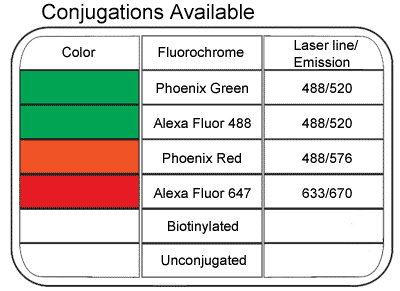Anti-BrdU monoclonal antibody is offered as a stand alone product, for use in labeling cells that have incorporated BrdU (cells incubated in the presence of BrdU will incorporate this thymidine analog into any DNA that is synthesized during that time).
This antibody, from the PRB-1 clone, has long been established as the superior choice for labeling BrdU, for the following reasons:
- Best labeling characteristics;
- Least expensive;
- Only commercially available anti-BrdU that also labels BrU incorporated in RNA.
Description
BrdU is an analog of thymidine (derivative of uridine) and can be incorporated specifically into DNA in place of thymidine. Cells can be pulse-labeled with BrdU, and those cells that are synthesizing DNA (in S-phase of the cell cycle) will incorporate BrdU into the DNA. Anti-BrdU can then be used to identify cells that undergo DNA synthesis during exposure to BrdU. The proportion of cells in Sphase of the cell cycle can be determined either by fluorescence microscopy or by flow cytometric analysis.
Specificity
5-Bromo-deoxyuridine (BrdU) is a uridine derivative that can be incorporated into DNA in place of thymidine. Anti-BrdU identifies BrdU (but not thymidine) in single-stranded DNA, free BrdU, or BrdU coupled to a protein carrier. The antibody also reacts with iodouridine.
Clone
Anti-BrdU, clone PRB-1, is derived from the hybridization of mouse myeloma cells with spleen cells from BALB/C mice immunized with iodouridine-conjugated ovalbumin.
Ig Chain Composition
Anti-BrdU is composed of mouse IgG1 heavy chains and kappa light chains.

|